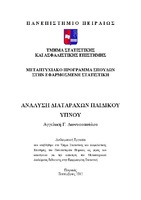Ανάλυση διαταραχών παιδικού ύπνου
Analysis of infant sleep disorders

View/
Abstract
Many studies, particularly in Great Britain and the USA, have shown that parental behavior and the way of resolving the child before and during sleep in its infancy, significantly affect the development of child sleep disorders. The data is recorded by means of appropriate questionnaires and quantified using scales arising from them. In order to study this problem in Greece and the various factors that may affect the social and emotional development of children, a significant number of self-completion questionnaires have been translated, a large part of which are applied for the first time in the Greek reality, and is analyzed primarily in a basic Likert-type scale. The survey was conducted by the TEI of Epirus in the Infant Care Department headed by Mrs Mantziou, Professor of Developmental Psychology, and her colleagues. These questionnaires have been completed by 431 people, mostly mothers, in Ioannina, Crete and Corfu. The topic of the present thesis is, in a first stage, the evaluation of those questionnaires on the whole, as a tool of study of sleep problems in children and the comparison of its implementation in Greek reality to the international experience. For this reason, the second chapter deals with the study and the evaluation of the reliability and validity of the questionnaires, while the fourth chapter examines the formation of the scales and the comparison of them to the international data through a factor analysis procedure. In a second stage, the sample of questionnaires will be analyzed in order to identify the factors that have an significant impact on the infant sleep behavior. The type and the form of the questions initially lead us to introduce categorical variables (nominal or ordinal) and to cross-classify them, forming thus contingency tables. The structure of relations that are developed between the factors considered and the infant sleep behavior will be studied via suitable association models that assume specific structure for the local odds ratios of the corresponding contingency table. The theoretical part will be studied in the third chapter. Finally, infantile sleep and its dependence on certain factors will be analyzed in the sixth chapter.


